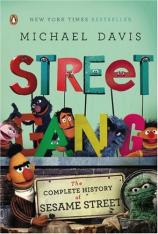Street Gang: The Complete History of Sesame Street
Review
Street Gang: The Complete History of Sesame Street
One of the favorite stories I've heard my parents tell is about how, on the morning of their wedding, the whole crew of bridesmaids, groomsmen --- even the groom himself --- nearly missed getting to the church on time because they were so transfixed by a hip new television show they were watching in my dad's hotel room. That program? “Sesame Street.” When I was younger, having been raised on a steady diet of “Sesame Street” and its offspring, the idea of a bunch of grownups sitting around watching a kids' show seemed bizarrely funny to me. In the historical and pop cultural context explained by Michael Davis in STREET GANG, however, the behavior of my parents' wedding party makes a whole lot more sense.
The first generation of kids who saw “Sesame Street” as preschoolers are now in their 40s, so anyone younger than that probably has a hard time grasping just how revolutionary the show was when it debuted in 1969. Compared with other children's television options --- which ranged from the ridiculous (such as “Howdy Doody”) to the painfully didactic --- it was clear that “Sesame Street” took a radically different approach to reaching, and teaching, its young target audience. Peopled with a multiethnic cast (not to mention those many-hued Muppets), the show used (and still uses) a gritty, realistic urban environment as a backdrop for its silly, sublime segments, thereby directly relating to the kids who need the show most --- those who don't necessarily have access to high-quality, early-childhood education programs. Like its predecessors, “Sesame Street” successfully used advertising taglines and jingles to reach an impressionable young audience. But the product it was selling was not toys or breakfast cereal --- it was numbers, letters and other early learning concepts.
Because it has flourished for so long, it's easy to overlook just how much the show in its infancy was a product of its times. The creators --- many of whom learned their trade as part of the staff of CBS's “Captain Kangaroo” --- were idealistic, progressive thinkers who saw the rapid rise of television as an opportunity to extend smaller-scale educational initiatives to reach the largest possible audience and have a positive influence on children's lives and educational success. "They came together at a star-crossed moment in American life," writes Davis, "when people of means who lived in comfort chose to dedicate their energies to the less fortunate and the forgotten, the rural poor and the underprivileged of the urban ghettos." Davis clearly relates how a show like “Sesame Street” can be seen as part of the larger civil rights and social justice initiatives that inspired this generation in the 1960s.
Readers who come to STREET GANG expecting a tell-all account of behind-the-scenes mayhem and secret scandals might be slightly disappointed with the book. Although Davis does relate some of the show's darker moments and personality clashes, the bulk of the book actually takes place before the series even premiered, as Davis relates how a handful of folks, particularly Children's Television Workshop founder Joan Ganz Cooney, navigated the murky waters of educational research, philanthropic funding and the nascent public broadcasting movement in order to achieve their objectives. Davis does explore the backstories of producers, actors, composers and others --- all of whom found their way to the most famous address on television, many of whom stayed there for the remainder of their careers. Cooney and Muppet master Jim Henson (whose moving memorial service serves as the backdrop for the book's prologue) are clearly the heart of the narrative, but Davis --- who obviously writes with the enthusiasm of a true fan --- overlooks none of the contributors who have made the show the success it continues to be today.
Davis, a long-time TV Guide columnist, clearly knows his stuff, and he places his subject firmly in its historical and cultural context. Perhaps the greatest contribution of STREET GANG will be to get readers like me --- those who remember “Sesame Street” fondly as children --- to look back at some of those early episodes (now available on DVD) as adults, to witness the wonder, accomplishment and revolutionary spirit of the show with brand-new eyes. Maybe my parents' wedding party wasn't so crazy after all.
Reviewed by Norah Piehl on January 23, 2011
Street Gang: The Complete History of Sesame Street
- Publication Date: October 27, 2009
- Genres: Entertainment, Nonfiction
- Paperback: 384 pages
- Publisher: Penguin (Non-Classics)
- ISBN-10: 0143116630
- ISBN-13: 9780143116639




